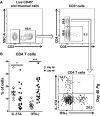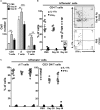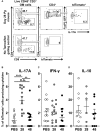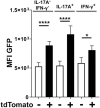Transient Expression of IL-17A in Foxp3 Fate-Tracked Cells in Porphyromonas gingivalis-Mediated Oral Dysbiosis
- PMID: 32391008
- PMCID: PMC7190800
- DOI: 10.3389/fimmu.2020.00677
Transient Expression of IL-17A in Foxp3 Fate-Tracked Cells in Porphyromonas gingivalis-Mediated Oral Dysbiosis
Abstract
In periodontitis Porphyromonas gingivalis contributes to the development of a dysbiotic oral microbiome. This altered ecosystem elicits a diverse innate and adaptive immune response that simultaneously involves Th1, Th17, and Treg cells. It has been shown that Th17 cells can alter their gene expression to produce interferon-gamma (IFN-γ). Forkhead box P3 (Foxp3) is considered the master regulator of Treg cells that produce inhibitory cytokines like IL-10. Differentiation pathways that lead to Th17 and Treg cells from naïve progenitors are considered antagonistic. However, it has been reported that Treg cells expressing IL-17A as well as IFN-γ producing Th17 cells have been observed in several inflammatory conditions. Each scenario appears plausible with T cell transdifferentiation resulting from persistent microbial challenge and consequent inflammation. We established that oral colonization with P. gingivalis drives an initial IL-17A dominated Th17 response in the oral mucosa that is dependent on intraepithelial Langerhans cells (LCs). We hypothesized that Treg cells contribute to this initial IL-17A response through transient expression of IL-17A and that persistent mucosal colonization with P. gingivalis drives Th17 cells toward an IFN-γ phenotype at later stages of infection. We utilized fate-tracking mice where IL-17A- or Foxp3-promoter activity drives the permanent expression of red fluorescent protein tdTomato to test our hypothesis. At day 28 of infection timeline, Th17 cells dominated in the oral mucosa, outnumbering Th1 cells by 3:1. By day 48 this dominance was inverted with Th1 cells outnumbering Th17 cells by nearly 2:1. Tracking tdTomato+ Th17 cells revealed only sporadic transdifferentiation to an IFN-γ-producing phenotype by day 48; the appearance of Th1 cells at day 48 was due to a late de novo Th1 response. tdTomato+ Foxp3+ T cells were 35% of the total live CD4+T cells in the oral mucosa and 3.9% of them developed a transient IL-17A-producing phenotype by day 28. Interestingly, by day 48 these IL-17A-producing Foxp3+ T cells had disappeared. Therefore, persistent oral P. gingivalis infection stimulates an initial IL-17A-biased response led by Th17 cells and a small but significant number of IL-17A-expressing Treg cells that changes into a late de novo Th1 response with only sporadic transdifferentiation of Th17 cells.
Keywords: Foxp3; IL-17A; Porphyromonas gingivalis; Th17 cells; Treg cells; fate-tracking; periodontitis.
Copyright © 2020 Bittner-Eddy, Fischer and Costalonga.
Figures







Similar articles
-
Mucosal Langerhans Cells Promote Differentiation of Th17 Cells in a Murine Model of Periodontitis but Are Not Required for Porphyromonas gingivalis-Driven Alveolar Bone Destruction.J Immunol. 2016 Aug 15;197(4):1435-46. doi: 10.4049/jimmunol.1502693. Epub 2016 Jul 11. J Immunol. 2016. PMID: 27402698 Free PMC article.
-
MyD88 exacerbates inflammation-induced bone loss by modulating dynamic equilibrium between Th17/Treg cells and subgingival microbiota dysbiosis.J Periodontol. 2024 Aug;95(8):764-777. doi: 10.1002/JPER.23-0561. Epub 2024 Mar 25. J Periodontol. 2024. PMID: 38523602
-
Interleukin-12 converts Foxp3+ regulatory T cells to interferon-γ-producing Foxp3+ T cells that inhibit colitis.Gastroenterology. 2011 Jun;140(7):2031-43. doi: 10.1053/j.gastro.2011.03.009. Epub 2011 Mar 17. Gastroenterology. 2011. PMID: 21419767 Free PMC article.
-
The role of T helper 17 (Th17) and regulatory T cells (Treg) in human organ transplantation and autoimmune disease.Clin Exp Immunol. 2007 Apr;148(1):32-46. doi: 10.1111/j.1365-2249.2007.03356.x. Clin Exp Immunol. 2007. PMID: 17328715 Free PMC article. Review.
-
Porphyromonas gingivalis: major periodontopathic pathogen overview.J Immunol Res. 2014;2014:476068. doi: 10.1155/2014/476068. Epub 2014 Mar 25. J Immunol Res. 2014. PMID: 24741603 Free PMC article. Review.
Cited by
-
Activation of bone marrow-derived dendritic cells and CD4+ T cell differentiation by outer membrane vesicles of periodontal pathogens.J Oral Microbiol. 2022 Sep 14;14(1):2123550. doi: 10.1080/20002297.2022.2123550. eCollection 2022. J Oral Microbiol. 2022. PMID: 36312320 Free PMC article.
-
mTOR Signaling in the Regulation of CD4+ T Cell Subsets in Periodontal Diseases.Front Immunol. 2022 Feb 10;13:827461. doi: 10.3389/fimmu.2022.827461. eCollection 2022. Front Immunol. 2022. PMID: 35222410 Free PMC article. Review.
-
Is the oral microbiome a source to enhance mucosal immunity against infectious diseases?NPJ Vaccines. 2021 Jun 2;6(1):80. doi: 10.1038/s41541-021-00341-4. NPJ Vaccines. 2021. PMID: 34078913 Free PMC article. Review.
-
Immunomodulation in the Treatment of Periodontitis: Progress and Perspectives.Front Immunol. 2021 Nov 19;12:781378. doi: 10.3389/fimmu.2021.781378. eCollection 2021. Front Immunol. 2021. PMID: 34868054 Free PMC article. Review.
-
Effects of Foxp3 gene silencing on the expression of inflammatory cytokines and the proliferation and migration of human periodontal ligament fibroblasts in an inflammatory environment.Hua Xi Kou Qiang Yi Xue Za Zhi. 2023 Jun 1;41(3):269-275. doi: 10.7518/hxkq.2023.2022409. Hua Xi Kou Qiang Yi Xue Za Zhi. 2023. PMID: 37277792 Free PMC article. Chinese, English.
References
Publication types
MeSH terms
Substances
Grants and funding
LinkOut - more resources
Full Text Sources
Research Materials

